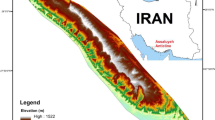Abstract
The object of this study is to consider directly the influence of regional geological conditions on the assessment of seismic hazard. It is assumed that macroseismic data at individual locations contain, in an average way, the influence of geological conditions.
A Data Base referring to 199 historical (5) and instrumental (194, in the 1947–1993 period) events with macroseismic information in 1195 locations of Portugal was built. For any given seismic event, whenever macroseismic information was available at a location (town, village, etc.), an EMS-92 intensity value was estimated. To each one of those locations a geological unit, representing the most common type of soil, was assigned, based on the Geological Portuguese Map at a scale 1:500 000; the geological units were grouped into three categories: soft, intermediate and hard soils.
The Data Base was used to determine the attenuation laws in terms of macroseismic intensity for the three different geological site conditions, using multiple linear regression analysis. The reasonability of the laws was tested by (i) checking residual distributions and (ii) comparing the map of isoseismals of important earthquakes with the isoseismals generated by the attenuation curves derived for each one of the three different soil classes, taking into consideration the soil class of each site. The main results of attenuation modeling are: high dispersion on macroseismic intensity data; all the models predict intensity values, for short hypocentral distances, lower than the ones observed; and for some important analyzed earthquakes and for the observed range of distances, the models confirm the expectancy that macroseismic intensity increases from hard to soft soil.
The approach to obtain the hazard assessment at each location consisted in the use of the attenuation law specifically derived for the class of soil of that particular location. This method, which considers the influence of the regional geology, was illustrated with the mapping of hazard for the country for several return periods. Comparison with previous maps not taking into consideration the regional geological conditions emphasizes the importance of this new parameter. It can be concluded that (i) soil segmentation is clearly the cause for hazard increase in the region to the north of Lisbon, especially at sites with soft and intermediate soils as the ones in lower Tagus valley; the maximum increase on hazard is, in any case, less than one degree; (ii) when geological conditions are disregarded in the attenuation regression analysis, hazard pattern is similar to the one obtained for the case of hard soil everywhere.
Similar content being viewed by others
References
Cabral, J.: 1993, Neotectónica de Portugal Continental, PhD thesis, Lisbon University, Lisbon.
Campos-Costa, A., Oliveira, C. S., and Sousa, M. L.: 1992, Seismic hazard-consistent studies for Portugal, Proc. 10th World Conference on Earthquake Engineering, Madrid. Balkema, Rotterdam, pp. 477–482.
DGMSG — Direcção Geral de Minas e Serviços Geológicos: 1972, Carta Geológica de Portugal. 1: 500 000, 4th edn, coordinated by Carlos Teixeira, Lisbon.
ENV 1988–1–1: 1994, Eurocode 8 — Design Provisions for Earthquake Resistance of Structures — Part 1 - 1: General Rules — Seismic Actions and General Requirements for Structures, CEN, Brussels.
Grünthal, G. (Ed.): 1993, European Macroseismic Scale 1992 (up-dated MSK-scale), Conseil de l'Europe. Chaiers du Centre Européen de Géodynamique et de Sismologie, Vol. 7, Luxembourg.
Howell, B. F. and Schultz, T. R.: 1975, Attenuation of modified mercalli intensity with distance from the epicentre, Bull. Seismol. Soc. Am. 65(3), 651–665.
Lee, V. W. and Manic, M.: 1994, Empirical Scaling of Response Spectra in Former Yugoslavia, Proc. 10th European Conference on Earthquake Engineering, Vienna, Balkema, Rotterdam.
McGuire, R. K.: 1976, EQRISK, Evaluation of Earthquake Risk to Site. Open File Report 76-67, United States Department of the Interior Geological Survey.
Oliveira, C. S., Campos-Costa, A., Sousa, M. L., Martins, A., Paula, A., Guedes, J., and Lucas, A.: 1995, Estimativa dos Danos Causados por Sismos no Parque Habitacional do Continente Português. Contribuição para a Definição de uma Política de Seguros, Study for the Associação Portuguesa de Seguradores, Lisbon.
Paula, A.: 1994, Avaliação de Informação Macrossísmica dos Sismos Sentidos em Portugal Continental no Período 1947–1993. Estudos de Atenuação, Graduation thesis, Faculty of Sciences, Lisbon University, Lisbon.
Paula, A. and Oliveira, C. S: 1995, Evaluation of 1947–1993 macroseismic information in Portugal using EMS-92 Scale, Paper submitted for publication in Annali di Geofisica.
Sousa, M. L.: 1996, Modelos Probabilistas para a Avaliação da Casualidade Sísmica em Portugal Continental, MSc thesis, Lisbon Technical University, Lisbon.
Sousa, M. L., Martins, A., and Oliveira, C. S.: 1992, Compilação de Catálogos Sísmicos da Região Ibérica, Report 36/92 — NDA, Laboratório Nacional de Engenharia Civil, Lisbon.
Sousa, M. L., Oliveira, R. C., and Oliveira, C. S., 1996, Análise Probabilista da Casualidade Sísmica em Portugal Continental, Paper presented at the 7th Congress of APDIO (Portuguese Association for the Development of Operational Research), Aveiro, Portugal, and submitted for publication at Investigação Operacional.
Trifunac, M. D.: 1990, How to model amplification of strong ground motion by local soil and geological site conditions, Earthq. Engi. Struct. Dynam. 19(6), 833–846.
Author information
Authors and Affiliations
Additional information
An erratum to this article is available at http://dx.doi.org/10.1023/A:1017104804770.
Rights and permissions
About this article
Cite this article
Sousa, M.L., Oliveira, C.S. Hazard mapping based on macroseismic data considering the influence of geological conditions. Nat Hazards 14, 207–225 (1996). https://doi.org/10.1007/BF00128267
Received:
Revised:
Issue Date:
DOI: https://doi.org/10.1007/BF00128267




